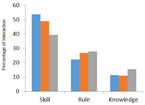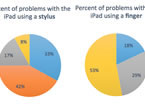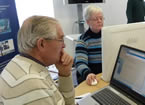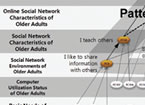Articles about Adultos mais velhos
(English) The Importance of Designing for the Elderly in a Post-COVID World

(English) One major impact of COVID-19 has been the rapidly rising number of older adults using the internet to work, shop, engage in social activities, and stay connected to family and friends. Many in this demographic, while they have real-world knowledge and experiences, may have challenges using online technologies and mobile devices. Hossein Raspberry provides insights on demystifying inclusive design and driving accessibility design in technology. [Leia mais]
O ativismo e a COVID-19: mulheres mais velhas do sudeste da Ásia adotam tecnologia

A study describing how older women in Southeast Asia have used technology to spread positivity and creativity during COVID-19. [Leia mais]
Serviços bancários on-line para todos: Design para o cérebro em processo de envelhecimento

Projetos para o cérebro em processo de envelhecimento ou para aqueles com pouca experiência em computador exigem rigor na definição da funcionalidade do website, fluxos de trabalho claros e distrações mínimas na página. [Leia mais]
Projetar para usuários vulneráveis: as ilustrações (podem ajudar) ajudam a compreender complexos websites da área de saúde

As ilustrações têm potencial para auxiliar na compreensão de informações complexas sobre saúde, mas o uso de imagens de forma eficaz requer testes para adequá-las às necessidades de uma ampla variedade de usuários. [Leia mais]
Colocando à prova a tecnologia do futuro: Experiência do Usuário para uma população que está envelhecendo

Uma análise da pesquisa atual foi usada para criar um framework para benchmarking ou uma ferramenta para refletir sobre as necessidades dos idosos para o projeto de tecnologias assistivas . [Leia mais]
Serviços de saúde on-line: Projeto de privacidade otimizado para idosos

Os desafios durante a criação de uma experiência de serviços on-line no Philips Home Monitoring para usuários idosos foram privacidade, experiência do usuário, limitações de sistemas herdados e comunicação. [Leia mais]
Colocar seu voto em um iPad: Desafios para idosos

Os idosos podem usar iPad para tarefas essenciais como votar? Os moradores de casas de repouso estão dispostos a tentar, porém enfrentam problemas com a interação de toque. [Leia mais]
(English) Never Too Old: Incorporating Digital Technologies into the Lives of Older Persons

(English) We need to learn how older people use technology to determine when and how to implement accessibility features rather than always seeking a “special” solution. [Leia mais]
(English) Social Network Sites for Older Adults: Online User Experience for Korean Seniors

(English) Designing social networking systems which meet the needs of current seniors will enable them to use these systems to improve their quality of life. [Leia mais]
(English) What Do We Know about Older Users? How Old is Old?

(English) Usability professionals have many of the same preconceptions about aging and technology use as those exhibited by people in other professions. [Leia mais]
(English) The Aging Brain: At the Crossroads of Attention and Memory

(English) Although slowed with aging, difficulties in suppressing irrelevant information, affecting attention span and memory retention, are found in all age groups. [Leia mais]
(English) Design for the Aging Brain (Commentary of Dr. Gazzaley’s The Aging Brain)

(English) We need to understand the mechanisms that underlie the physical and mental changes of aging to design products that interface well with older adults' cognitive abilities. [Leia mais]
(English) Conducting Field Studies with Older Adults Lessons for Recruiting and Testing Older Users

(English) Field testing and field research work especially well with older adults, if you are sensitive to their needs in both the recruiting and data collection process. [Leia mais]
(English) Designing Spaces for Dementia: An Interview with Terry Carson

(English) An interview with Terry Carson, the owner of residential facilities for people with dementia and Alzheimer's disease. [Leia mais]
(English) Geographic Orientation & Disorientation: Getting Lost and Getting Found in Real and Information Spaces
(English) To reduce problems of navigational disorientation, incorporate different sets of orientation factors and accommodate the needs and abilities of all users. [Leia mais]
(English) Web 2.0 for an Older Population: Exploring the Limits

(English) To enable a rapidly aging population with the connected social experiences that younger Web users experience, find balance between replacing and augmenting offline activity. [Leia mais]
(English) Older Users Online: WAI Guidelines Address the Web Experiences of Older Users
(English) A review of research into overlaps between the accessibility needs of older users and people with disabilities showed that WCAG 2.0 meets most of the identified requirements of older web users. The article introduces the WAI-AGE project. [Leia mais]
(English) The View from Here: When is Enough Enough?
(English) As we age, we are constantly compromising, and redefining what we view as living. [Leia mais]
(English) What’s News: Helping Seniors Helps Everybody
(English) With the aging of the baby boomers, product developers are realizing that there’s money to be made by making products more user-friendly to older people. [Leia mais]
(English) Book Review: Assisted Loving

(English) The book is a consciousness-raiser for family members who are dealing with aging seniors as they enter new phases of their lives. [Leia mais]
(English) Editor’s Note: Platinum Perspectives on Usability and User Experience
(English) The role of seniors have important implications for the policies and focus of attention for our professional organizations and daily life. [Leia mais]

